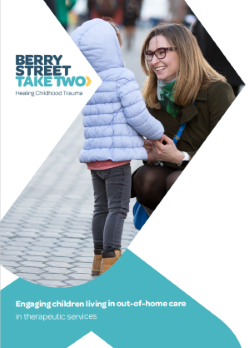Berry Street’s Take Two program has produced a practice guide to support others working with trauma-impacted children. We understand the critical importance of trauma-informed services and the unique challenges faced by trauma survivors. In the field of social work, the concept of trauma and guidance for addressing trauma exposure and traumatic events is paramount. Our guide, rooted in trauma-informed care principles, offers invaluable insights and strategies to empower professionals and caregivers in providing the best possible care and support to children who have experienced trauma.
Trauma-informed care approach

The Engaging children living in out-of-home care in therapeutic services practice guide provides information about some key considerations when responding to children who have experienced childhood trauma, and some practice implications.
It provides practical steps about how to understand and respond to concerning self-soothing behaviours, trust issues and includes a new engagement tool to help others working with these children plan sessions and approaches.
Also included is clinical advice about how to use some of Dr Bruce Perry’s Neurosequential Model of Therapeutics (NMT) concepts, particularly the idea of ‘dosing’ tolerable therapeutic interactions and using the 3Rs (regulate, relate and reason) approach to calm a child’s brain and behaviours.
This guide is the first in a planned series and will share key elements of Take Two’s system-wide, trauma-informed approach to working with children who are suffering developmental trauma as a result of neglect, family violence or abuse.
Key messages
Understanding the impact of trauma: Many children in out-of-home care have experienced trauma, primarily in the form of abuse and neglect. These traumatic experiences profoundly affect their emotional and physical development, making it essential to comprehend the lasting impact of trauma.
Recognising the effects of trauma: Trauma can manifest in complex behaviours in children who have experienced it. These behaviours may appear challenging and difficult to understand for adults, underscoring the importance of recognising the effects of trauma.
Embracing trauma-informed practice: Engaging in trauma-informed practice is essential when working with these children. This approach ensures that caregivers are informed about the nature of trauma and its potential consequences, guiding their interactions.
Adhering to the principles of trauma-informed care: Trauma-informed care is grounded in several key principles. One such principle is building trust with these children, understanding that their behaviours are adaptive responses to perceived danger.
Addressing adverse childhood experiences: Children in out-of-home care often have a history of adverse childhood experiences. It is crucial to acknowledge and address these experiences as part of the trauma-informed care approach.
Dealing with self-soothing behaviours: Children frequently employ self-soothing behaviours to cope with trauma. Some of these behaviours may be problematic. Supporting children in regulating their stress responses is vital before attempting behavioural change.
Fostering cultural sensitivity and safety: Recognising and respecting a child's cultural identity is fundamental to providing trauma-informed care. Involving caregivers and cultural advisers can enhance the process, aligning it with the principles of trauma-informed care.
Effective engagement planning: Planning for engagement with these children involves understanding their trauma history, engaging with caregivers, creating a safe environment, and establishing a predictable pattern of interaction, all rooted in trauma-informed practice.
A trauma-informed approach to care
Take Two Assistant Director Holly Mosse said improving practice across the sector makes a real difference to the community.
‘There are about 12,000 children in out-of-home care in Victoria right now and we’re funded to work with only a very small number of them,’ she said. ‘They’ve all suffered some sort of developmental trauma. Without support to help them recover, these traumatised children are less likely to be able to reach their full potential, and more likely to experience mental illness.’
'If we can help other people working with these very vulnerable children also adopt a trauma-informed approach, we can help more children and young people recover, feel safer and live more productive lives.’
Out-of-home care staff and carers often refer to Take Two clinicians as miracle workers. We’re not, we just have a strong understanding of how traumatic experiences can impact a child and the organisation of a child’s brain, body and behaviours.
Keep your eyes out for our future practice guides. Subscribe below to get them sent to your inbox. You can also read more stories and case studies about Take Two's work.
Berry Street’s Take Two service is a Victoria-wide therapeutic service helping to address the impact on children of the trauma they have experienced from abuse, neglect or adverse experiences. Take Two is a flagship site for the NMT approach developed by Dr Bruce Perry.



